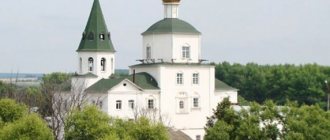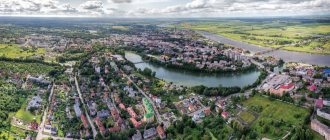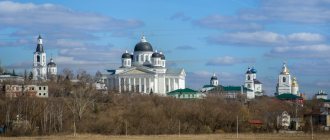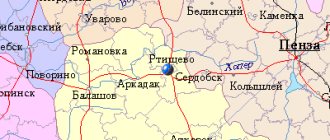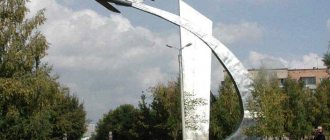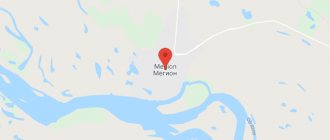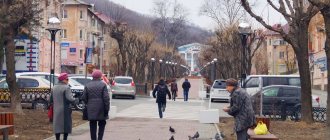The first mention of the city dates back to 1535. City status was granted in 1985.
Koryazhma on the map of Russia is part of the Arkhangelsk region. A district with the same name Koryazhma was formed around the city. The construction of the paper mill gave impetus to the development of the city and the increase in population.
Geographical area – 22.17 km2. In 2014, the city of Koryazhma was included in the list of cities in the Russian Federation with a risk of worsening socio-economic situation.
The main industrial production of the city and Koryazhma region is associated with the processing and production of cellulose.
Where is Koryazhma located?
The Russian Federation is a great state occupying most of Eastern Europe and part of Asia. The map of Russia contains many beautiful cities and mysterious places.
Koryazhma is located on the map of the Arkhangelsk region and is located on the banks of the Vychegda River in the southeastern vicinity of the Dvina Hollow. This settlement is 635 km away from the regional center, and its area is 22.1 square kilometers. Koryazhma enters an area with rock salt deposits. The name of the city comes from the name of the Koryazhemka River.
Koryazhemsky urban district includes:
- Koryazhma city;
- Horticultural partnership "Gardeners of the North";
- Gardening partnership "Stroitel".
Routes on the map of Koryazhma. Transport infrastructure
Near the city there is a railway station providing transportation of passengers in the directions of Moscow and St. Petersburg. The railway station is called "Nizovka" . On the map of Koryazhma with streets you can see the distance of the stations from the city.
Air traffic for residents and tourists visiting Koryazhma is available through the airport located on the territory of the city of Kotlas. Here passenger aircraft operate in the following directions:
- Arkhangelsk.
- Syktyvkar.
- Saint Petersburg.
Koryazhma has connections with major cities thanks to passenger buses in the following directions:
- Kotlas.
- Arkhangelsk.
- Solvychegodoms.
- Syktyvkar.
- Veliky Ustyug.
- Kirov.
- Severodvinsk.
- Krasnoborsk.
City transport consists of passenger buses that run according to a schedule and a specific route. In total, there are 6 public passenger transport routes in the city.
Story
- If you believe historical facts, it all starts in 1535. Then the first settlement appeared on the territory of the modern city. The chronicle contains information that the Pavlo-Obnorsky Monastery was founded at this time.
- In the Orthodox world, the city of Koryazhma is famous for its relatively large number of churches. One of the oldest buildings is the Church of the Savior Not Made by Hands. This is a single-domed small temple. The temple was erected in the 18th century with money from the monastery treasury, and was consecrated only in 1746.
- In 1916, industrialists Ryabushinsky decided to build a stationery factory and purchased a plot of land located near Koryazhma. This brought about changes and just a year later, in 1917, collective farms were organized in nearby settlements.
- In 1937, oil exploration was carried out in areas adjacent to the city. Subsequently, the well was converted for the extraction of mineral water and in 1969 the supply to the dispensary was organized.
- The post-war years were marked by the construction of the Koryazhemskaya timber depot and elevator.
- By the 1960s, the population had risen to 25 thousand people. The construction of small apartment buildings of 2-3 floors began in the village.
- In 1961, the first products of the Kotlas pulp and paper plant were produced, which later became the largest and most famous in the world; After another 2 decades, the settlement was transformed into a city.
- Now the city is famous not only for its temples, but also for the production of coated paper. In 2010, she began building a plant.
LiveInternetLiveInternet
Thursday, March 13, 2008 19:45 + to quote book Igor_Vasyukov
all posts by the author
After the revolution of 1917, a public economy arose on the former monastery lands. Collective farms were formed in the villages of Slobodka, Glubokoe, Bolshoye and Maloye Kopytovo and Koryazhemka. In 1921, the All-Russian Conference of Plant Managements and Factory Committees of the Paper Industry in its decision included Kotlas among the regions for the development of the paper industry. At the December plenum of the Central Committee of the All-Union Communist Party of Bolsheviks, a message was made that construction of the plant would begin in 1936 and the site was named near the village of Koryazhemka in the Solvychegodsk district of the Arkhangelsk region. The Great Patriotic War suspended construction. The construction experienced a rebirth in 1953. On June 17, 1953, by order of Glavlesbumstroy, the Kotlasbumstroy trust was organized. In 1954, 359 workers, engineers and employees worked on construction, who built about 200 four-apartment buildings and several dozen panel hostels. In 1954, work began on the construction of the plant's facilities: heating plant No. 1, a mechanical repair plant, and a locomotive depot. In 1954, the first two-story brick houses appeared, the first secondary school for 800 students, a complex of industrial enterprises was formed, builders began work on the main technological lines of the first stage of the plant. In March 1957, the Koryazhemsky village council was formed. The first cinema with 370 seats began operating in 1958, and the bakery came into operation. In 1959, the construction of the road between the plant and Nizovka station and a milk processing plant was completed. A branch of the Arkhangelsk Forestry Engineering Institute was opened in Koryazhma, a music school was opened, and a boarding school accepted its first students. On August 14, 1961, the first cellulose was produced at the plant. In the same year, the city hospital opened and provided the first power to CHPP-1. The future city grew and developed on the construction site. In 1962, the construction site of the plant was 900 hectares, where 41 objects were located. In December 1964, the start-up complex of the second stage of the plant was put into permanent operation. The list of new buildings in the village has been expanded. The House of Culture of Bumazhnikov opened its doors, another school opened, the little Koryazhem residents received three kindergartens, a department store "Rainbow" and a household goods store as a gift. And in 1965, the Nizovki station came into operation, the Northern Lights camp welcomed the first pioneers to rest, and a school for working youth was opened. On the eve of the 50th anniversary of the Great October Revolution, the Palace of Pioneers opened its doors, a monument to V.I. Lenin was unveiled on the square, the Zarya sanatorium-preventorium of the Kotlas pulp and paper mill, a clinic for 500 visits per shift, and a new boarding school were put into operation. In 1971, gasification of the village began. Year 1972 - start-up at the plant. The first complex of the third stage for the production of 82 thousand tons of gravure printing paper was put into operation. On New Year's Eve 1974, Koryazhem residents watched the first programs of Central Television. In 1975, 42 thousand people lived in Koryazhma. In 1980, the Kultovary store received its first customers, a children's library was opened, and an obelisk of Glory to the soldiers who died during the Great Patriotic War was opened on the street of the N. Ostrovsky embankment. In 1981, the residents of Koryazhem received a beautiful sports palace “Olympus” as a gift, and a monument to M.V. Lomonosov was opened on Mayakovsky Street and the street began to bear the name of the outstanding countryman. In 1982, the Children's Goods store opened. In 1985, three large industrial enterprises operated in the village: Kotlas Pulp and Paper Mill, Chemical Plant and Checkpoint. The fate of Koryazhma was determined by the Kotlas pulp and paper mill. In just over three decades, Koryazhma has gone through its development path. By this time, the village consisted of 5 microdistricts, 27 streets, 2 avenues. On August 15, 1985, by decree of the Presidium of the Supreme Soviet of the RSFSR, the working village of Koryazhma was classified as a city of regional subordination, retaining its previous name. On October 31, 1985, the first session of the Koryazhemsky City Council of People's Deputies took place, which determined the first composition of the executive committee, consisting of two people. The city is still young, but its biography is quite rich. And it is written by the golden hands of paper workers, builders, doctors, teachers and other residents. The city continues to grow and grow. MUNICIPAL FORMATION “THE CITY OF KORYAZHMA” The municipal formation “Town of Koryazhma” was registered in the Federal Register of the Moscow Region in the Russian Federation on June 17, 1999 under No. 000105. There is no administrative division in the municipality. Its center is the city of Koryazhma. The status of a city of regional subordination to Koryazhma was assigned by Decree of the Presidium of the Supreme Soviet of the RSFSR dated August 15, 1985 No. 1215. The city of Koryazhma is located in the south-eastern vicinity of the Dvina Hollow, 35 kilometers from the mouth of the Vychegda River, on its left bank, near the Nizovka railway station on the Kotlas-line. Mikun, 40 km east of Kotlas. The city is connected to the regional center by rail and road transport. The distance from the center of the municipality to the nearest railway station is 8 km. More than 5 thousand hectares are allocated for urban land. According to the preliminary results of the All-Russian Population Census conducted in 2002, the permanent population of the city of Koryazhma was 42.8 thousand people. The economic specialization of the municipality consists of the following industries: pulp and paper, chemical and building materials industry. From 1985 to the present, the city-forming enterprise of the municipality is the Kotlas Pulp and Paper Mill (since 1992, OJSC Kotlas Pulp and Paper Mill). Over the 40 years of its production activity, the Kotlas Pulp and Paper Mill has become one of the country's leading timber industry enterprises. The city operates: 2 municipal health care institutions - Koryazhemsk city hospital and dental clinic, 8 municipal secondary schools, 16 preschool educational institutions, an evening school, a state educational institution, a special correctional boarding school for orphans and children without parental care, an interschool educational and technical center, orphanage for creativity, city information and methodological center, two institutions of primary vocational education: vocational school No. 33 and vocational technical lyceum No. 5, a branch of the Arkhangelsk State College of Economics, Statistics and Informatics with evening courses, a branch of Pomorsky State University named after. M.V. Lomonosov and the non-state educational institution “Northern Branch of the Moscow Humanitarian-Economic Institute”, a representative office of Vyatka State University has been opened with correspondence courses. Since 1993, an art school has been opened in the city; before that there was only a music school. The School of Art is located in a new, modern and spacious building. Currently, it successfully represents 8 departments: piano, folk, strings, choral, choreographic, artistic, arts and crafts, and theoretical. Koryazhma has a developed centralized library system, which includes four branches (children's, youth, city library and central children's library). There are two cultural institutions: the City House of Culture, the House of Culture of OJSC Kotlas Pulp and Paper Mill. Cultural and sports institutions also function effectively: the Olympus Sports Palace of Kotlas Pulp and Paper Mill OJSC, which has gyms and a swimming pool, and the Trud stadium, which has the best football field in the region. Particularly popular is the sanatorium - the Zarya dispensary of the Kotlas Pulp and Paper Mill OJSC, where more than 4 thousand people a year have the opportunity to improve their health and relax. Source and photo: https://www.koradm.ru/hist_stat/ Place on the map
| Categories: | history geography tourist routes museums Arkhangelsk region |
Tags:
map of the Arkhangelsk region guide to the Arkhangelsk region history of the Arkhangelsk region travel to the Arkhangelsk region snags industry of the Arkhangelsk region
Cited 1 time
Like share
0
Like
- I liked the post
- Quoted
- 0
Saved
- Add to quote book
- 0
Save to links
Liked
0
Flora and fauna
The map of Russia shows different temperature zones. Each territory has different weather conditions, and therefore a set of plants and animals.
The Arkhangelsk region is distinguished by the pristine beauty of the taiga massifs and subarctic tundra. This is the kingdom of permafrost, which means there is rather sparse vegetation here. On the territory of the forest-tundra you can see swampy areas and open forests, as well as taiga dark coniferous forests.
Pine forests are also widespread, and in the east - fir forests. You can find edible berries:
- Strawberries;
- Cloudberry;
- Black and red currants;
- Blueberry;
- Blueberry;
- Cowberry;
- Rowan and others.
There are many mushrooms growing in the south, such as:
- Saffron milk caps;
- Milk mushrooms;
- Porcini mushrooms and others.
Animals have a hard time, as living conditions here are harsh. Therefore, here you can find animals of continental latitudes, adapted to survive at low temperatures. In the forests you can find:
- Polar bears;
- Walruses;
- Seals;
- deer and other fauna.
Main streets of Koryazhma
There are 57 streets in Koryazhma. Main streets of the city:
- Street named after Dybtsyn - the street is named after the director of the pulp mill, a hero of labor. On the street there is the Vychegda Hotel, a shopping center, a clinic, and a sports stadium.
- Arkhangelskaya Street - on the street there is a large number of shops, a shopping center, a clinic, a traffic police building, a school and a city hospital.
- Lenin Avenue – there are several schools, kindergartens, shopping and grocery stores.
- Kutuzova Street - on the street there is a city court, a fire station building, kindergartens and a cultural center.
The necessary addresses and building numbers can be found on the map of Koryazhma with houses.
Monuments
- “Human Life” is a sculptural ensemble that was installed in 2005. This ensemble includes 11 different sculptures.
- The Obelisk of Glory is a memorial. The main difference of this pedestal is the five-pointed star at the main stele. There is a lot to see here! The faces of a soldier and a grieving mother are cast from cast iron, and on the obelisk are the names of 122 brave Koryazhem residents who went missing.
- Monument to Hero of the Soviet Union Alexander Matrosov, who near the village of Chernushki on February 23, 1943, covered the bunker embrasure with his body and thanks to this saved his comrades. The memorial was erected at the expense of students in the park of school No. 2.
- The Aerosleigh monument is dedicated to the creation of the Aerosleigh Board and the Kotlas Aerosleigh Military School.
- In Koryazhma there is a small copy of the monument to Mikhailo Vasilyevich Lomonosov, located in Moscow. The monument was erected on the occasion of the 270th anniversary of the scientist and his belonging to the Arkhangelsk land, in October 1981.
- In 2008, on November 15, a monument to the first builders of the city of Koryazhma was erected. This is a brick wall, on the right is a boom from a construction crane and on the left is a safety helmet used by construction workers.
- Monument to the “Diesel Locomotive TGC-2”, which spent more than 40 years on the railway of the Kotlas Pulp and Paper Plant. In advance, major restoration work was carried out on the diesel locomotive.
- The Nika sculpture is a significant symbol of the pulp and paper mill. This is a combination of the image of the goddess of victory and the shaft of the machine on which paper products were made.
- Monument to Vladimir Ilyich Lenin.
What sights of their hometown do Koryazhem residents know?
- May 12, 2014 — 20:17
- 1160Views
Author: Alexander Borisov Photo: photo by the author
There are many attractions in Koryazhma: historical, cultural, industrial, natural. And any of these reasons for pride is the result of the work of townspeople, residents of what was once a working-class village, and even earlier, villagers and monks. You shouldn’t judge the survey participants harshly on the short answers they gave; they didn’t prepare for it in advance and probably remembered a lot of interesting things later. But that's not the point. Koryazhem residents love their city, know a lot about it, and would like to know even more. What has been mentioned is just the tip of the iceberg. After all, the Trud stadium, the Zarya and Vesna dispensaries, city schools, a hospital, the Palace of Pioneers (formerly DDT), the Lily greenhouse, monuments and fountains, parks, public gardens and so on - all can be attractions of Koryazhma.
Ivan TATARINOV employee of the Ilim group (water treatment)
– I live not far from the monument to Lomonosov, there is a monument to Matrosov. Walk of Fame on the shore, no doubt. Here's what quickly came to mind...
| Sergey Mikhailovich ROMANOV pensioner – Among the attractions: swimming pool, temple of St. Longinus. Our city is cozy, there is a river nearby. The construction of the plant is of historical significance. I worked here my entire working life, all Koryazhem residents are connected with the plant. This is history… | ||
- Uncle Lomonosov is standing there, there seems to be nothing else here... They built a park for children, what other attractions are there? I don't know anymore. I come from the Smolensk region, I remember, as a child, I collected nuts with my grandmother, and there is a cedar grove here, although I never went there myself.
– A music school, an administration building, a monument to fallen soldiers on the Embankment, a monument to Chernobyl victims and an alley with a monument to internationalist soldiers. There is also a monument to the trust workers (first builders). They still want to remake it. I don't know anymore.
– It’s difficult to answer. I don’t know what we can be proud of. A monument to Lomonosov would be considered a landmark. I also love school No. 2, where I studied from first to eleventh grade. By the way, there is a monument to Alexander Matrosov.
– The Church is the most sacred thing. There was a beer building nearby, a brick one, the church made sure it wasn’t nearby. I go to the shore sometimes. The Vychegda River is also a landmark. Previously, the pier was...
– I really like the city embankment, a very beautiful park, and the complex of the monastery of St. Longinus. The relict cedar grove is a rare attraction for our area. I like the art school, I really like Lenin Square, the Palace of Culture.
– Alexander Park, Embankment, obelisk... There are monuments. On Lenin Square - Lenin, a monument to Lomonosov on Lomonosov Avenue. There is a church next to our school.
<<<to list of topics
Parks and places open to the public
The city has the Cedar Grove Park - this is a memorable place. Here, in 1660–1670, the monks independently planted plants. This is a natural monument created by human hands. On the territory of the European north in the 20th century, the grove was the longest in area. Over time, fresh seedlings of larch and Siberian pine pine are planted next to the old planting, thereby restoring and protecting them from death. Forestry scientists compare this planting with the main source of cedar spread. Now the park's area is 17,500 square kilometers. This is the real pride of the city residents.
The main events of the city are held on the square of the Koryazhemsky cultural and leisure center.
Founded by the monks of the Pavlo-Obnorsky Monastery Longin and Simon Soiginsky, the Koryazhemsky Nikolaevsky Monastery is the main place in the city. Pilgrims from all over the country come here. The building has been restored, and the territory of the monastery is surrounded by a new fence.
In the city of Koryazhma there are many monuments of Russian architecture. Today it is a comfortable and developed city in the Arkhangelsk region. The rich history of the city and the availability of leisure facilities allow you to find entertainment for every taste.
Novodvinsk is a city with affordable housing
The city is located 20 km from Arkhangelsk and has similar nature and climate, but with more pronounced continental features. The population here is attracted mainly by the availability of housing. The number of residents has been constantly decreasing in recent years.
As of 2022, the total population was 38.7 thousand people. Moreover, more than 97% consider themselves Russian. In terms of religion, atheists dominate, with Orthodox Christians in second place. There is every reason to believe that the dynamics of population growth will continue to be negative. According to a number of indicators, Novodvinsk is the most polluted city in Russia. A very large number of thyroid diseases also indicates the presence of a serious problem.

